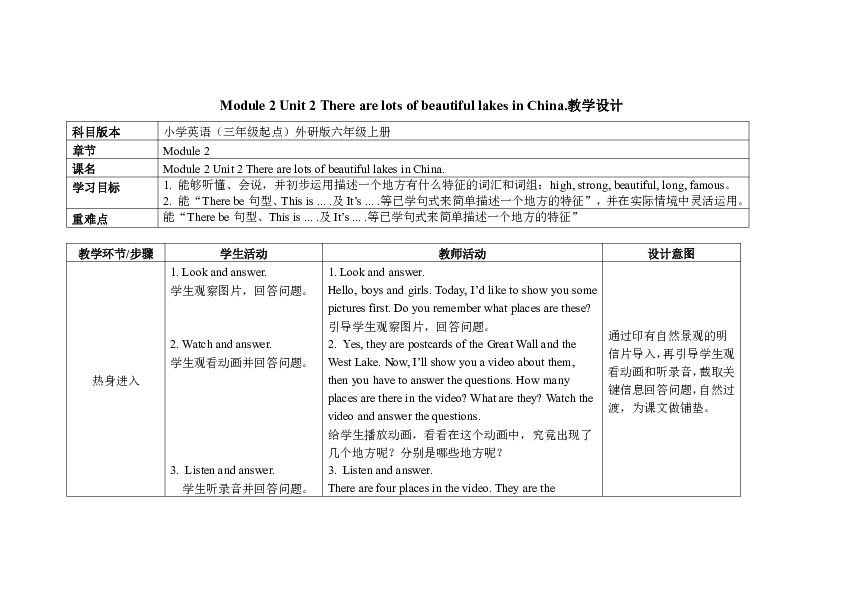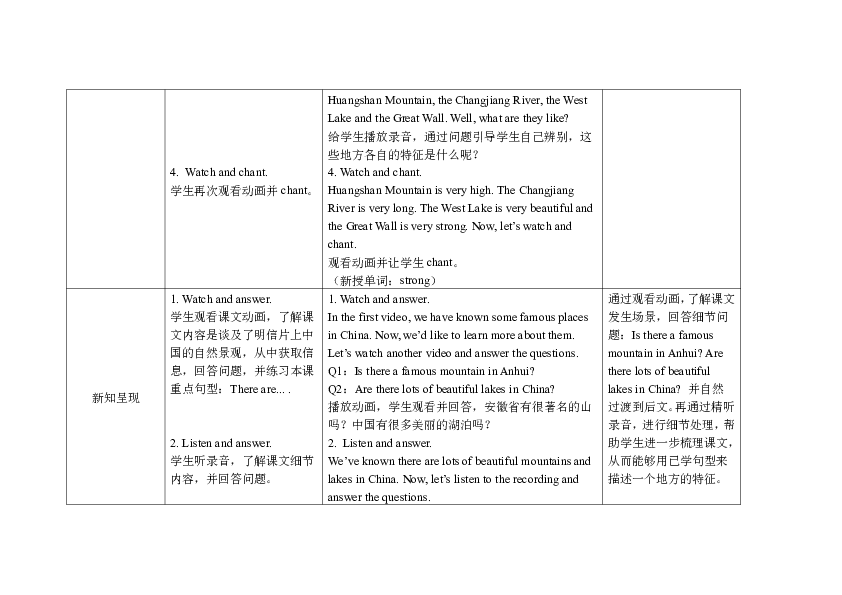Module 2 Unit 2 There are lots of beautiful lakes in China 教案
文档属性
| 名称 | Module 2 Unit 2 There are lots of beautiful lakes in China 教案 |  | |
| 格式 | zip | ||
| 文件大小 | 52.5KB | ||
| 资源类型 | 教案 | ||
| 版本资源 | 外研版(三年级起点) | ||
| 科目 | 英语 | ||
| 更新时间 | 2019-11-24 08:21:18 | ||
图片预览




文档简介
Module 2 Unit 2 There are lots of beautiful lakes in China.教学设计
科目版本 小学英语(三年级起点)外研版六年级上册
章节 Module 2
课名 Module 2 Unit 2 There are lots of beautiful lakes in China.
学习目标 1. 能够听懂、会说,并初步运用描述一个地方有什么特征的词汇和词组:high, strong, beautiful, long, famous。2. 能“There be句型、This is ... .及It’s ... .等已学句式来简单描述一个地方的特征”,并在实际情境中灵活运用。
重难点 能“There be句型、This is ... .及It’s ... .等已学句式来简单描述一个地方的特征”
教学环节/步骤 学生活动 教师活动 设计意图
热身进入 1. Look and answer.学生观察图片,回答问题。 2. Watch and answer.学生观看动画并回答问题。 Listen and answer. 学生听录音并回答问题。 Watch and chant.学生再次观看动画并chant。 1. Look and answer.Hello, boys and girls. Today, I’d like to show you some pictures first. Do you remember what places are these?引导学生观察图片,回答问题。Yes, they are postcards of the Great Wall and the West Lake. Now, I’ll show you a video about them, then you have to answer the questions. How many places are there in the video? What are they? Watch the video and answer the questions.给学生播放动画,看看在这个动画中,究竟出现了几个地方呢?分别是哪些地方呢?Listen and answer.There are four places in the video. They are the Huangshan Mountain, the Changjiang River, the West Lake and the Great Wall. Well, what are they like?给学生播放录音,通过问题引导学生自己辨别,这些地方各自的特征是什么呢?4. Watch and chant.Huangshan Mountain is very high. The Changjiang River is very long. The West Lake is very beautiful and the Great Wall is very strong. Now, let’s watch and chant.观看动画并让学生chant。(新授单词:strong) 通过印有自然景观的明信片导入,再引导学生观看动画和听录音,截取关键信息回答问题,自然过渡,为课文做铺垫。
新知呈现 1. Watch and answer.学生观看课文动画,了解课文内容是谈及了明信片上中国的自然景观,从中获取信息,回答问题,并练习本课重点句型:There are... . 2. Listen and answer.学生听录音,了解课文细节内容,并回答问题。 3. Watch and read.学生观看动画并跟读课文。 1. Watch and answer.In the first video, we have known some famous places in China. Now, we’d like to learn more about them. Let’s watch another video and answer the questions. Q1:Is there a famous mountain in Anhui? Q2:Are there lots of beautiful lakes in China?播放动画,学生观看并回答,安徽省有很著名的山吗?中国有很多美丽的湖泊吗?Listen and answer.We’ve known there are lots of beautiful mountains and lakes in China. Now, let’s listen to the recording and answer the questions.引导学生听录音,了解课文细节内容,并回答问题。让学生回答:How long is the Changjiang River? How long is the Great Wall?Watch and read.Ask students to watch and read the text. 让学生看动画并跟读课文。 通过观看动画,了解课文发生场景,回答细节问题:Is there a famous mountain in Anhui? Are there lots of beautiful lakes in China? 并自然过渡到后文。再通过精听录音,进行细节处理,帮助学生进一步梳理课文,从而能够用已学句型来描述一个地方的特征。
分步训练 Look and say.学生看图片并将句子填写完整。2.Make a show.学生看图片,并上台介绍图片。 Look and say.We’ve known some famous places in China. Now, let’s look at other pictures, and try to describe them..教师引导学生看图片完成句子。2. Make a show.Let’s read the sentences.教师鼓励学生上台介绍图片。 进一步训练如何用句型“There are....的句型”来表达某个地方有什么特征。
尝试应用 1. Make a dialogue.学生观察图片并创编对话。 2. Read in roles.学生角色扮演。 1. Talk about the picture.Now let’s talk about the picture.教师组织学生观察图片、讨论并创编对话。2. Read in roles.Ask students to read in roles.请学生进行角色扮演朗读。 能在实际情境中运用所学的句型。
作业布置 学生记录作业 Make a postcard for your family or friend, and describe your favourite place on the postcard.为你的家人或朋友制作一张明信片,并在明信片上向他们描述一下你最喜欢的一个地方的特色吧。 课堂内容小结
科目版本 小学英语(三年级起点)外研版六年级上册
章节 Module 2
课名 Module 2 Unit 2 There are lots of beautiful lakes in China.
学习目标 1. 能够听懂、会说,并初步运用描述一个地方有什么特征的词汇和词组:high, strong, beautiful, long, famous。2. 能“There be句型、This is ... .及It’s ... .等已学句式来简单描述一个地方的特征”,并在实际情境中灵活运用。
重难点 能“There be句型、This is ... .及It’s ... .等已学句式来简单描述一个地方的特征”
教学环节/步骤 学生活动 教师活动 设计意图
热身进入 1. Look and answer.学生观察图片,回答问题。 2. Watch and answer.学生观看动画并回答问题。 Listen and answer. 学生听录音并回答问题。 Watch and chant.学生再次观看动画并chant。 1. Look and answer.Hello, boys and girls. Today, I’d like to show you some pictures first. Do you remember what places are these?引导学生观察图片,回答问题。Yes, they are postcards of the Great Wall and the West Lake. Now, I’ll show you a video about them, then you have to answer the questions. How many places are there in the video? What are they? Watch the video and answer the questions.给学生播放动画,看看在这个动画中,究竟出现了几个地方呢?分别是哪些地方呢?Listen and answer.There are four places in the video. They are the Huangshan Mountain, the Changjiang River, the West Lake and the Great Wall. Well, what are they like?给学生播放录音,通过问题引导学生自己辨别,这些地方各自的特征是什么呢?4. Watch and chant.Huangshan Mountain is very high. The Changjiang River is very long. The West Lake is very beautiful and the Great Wall is very strong. Now, let’s watch and chant.观看动画并让学生chant。(新授单词:strong) 通过印有自然景观的明信片导入,再引导学生观看动画和听录音,截取关键信息回答问题,自然过渡,为课文做铺垫。
新知呈现 1. Watch and answer.学生观看课文动画,了解课文内容是谈及了明信片上中国的自然景观,从中获取信息,回答问题,并练习本课重点句型:There are... . 2. Listen and answer.学生听录音,了解课文细节内容,并回答问题。 3. Watch and read.学生观看动画并跟读课文。 1. Watch and answer.In the first video, we have known some famous places in China. Now, we’d like to learn more about them. Let’s watch another video and answer the questions. Q1:Is there a famous mountain in Anhui? Q2:Are there lots of beautiful lakes in China?播放动画,学生观看并回答,安徽省有很著名的山吗?中国有很多美丽的湖泊吗?Listen and answer.We’ve known there are lots of beautiful mountains and lakes in China. Now, let’s listen to the recording and answer the questions.引导学生听录音,了解课文细节内容,并回答问题。让学生回答:How long is the Changjiang River? How long is the Great Wall?Watch and read.Ask students to watch and read the text. 让学生看动画并跟读课文。 通过观看动画,了解课文发生场景,回答细节问题:Is there a famous mountain in Anhui? Are there lots of beautiful lakes in China? 并自然过渡到后文。再通过精听录音,进行细节处理,帮助学生进一步梳理课文,从而能够用已学句型来描述一个地方的特征。
分步训练 Look and say.学生看图片并将句子填写完整。2.Make a show.学生看图片,并上台介绍图片。 Look and say.We’ve known some famous places in China. Now, let’s look at other pictures, and try to describe them..教师引导学生看图片完成句子。2. Make a show.Let’s read the sentences.教师鼓励学生上台介绍图片。 进一步训练如何用句型“There are....的句型”来表达某个地方有什么特征。
尝试应用 1. Make a dialogue.学生观察图片并创编对话。 2. Read in roles.学生角色扮演。 1. Talk about the picture.Now let’s talk about the picture.教师组织学生观察图片、讨论并创编对话。2. Read in roles.Ask students to read in roles.请学生进行角色扮演朗读。 能在实际情境中运用所学的句型。
作业布置 学生记录作业 Make a postcard for your family or friend, and describe your favourite place on the postcard.为你的家人或朋友制作一张明信片,并在明信片上向他们描述一下你最喜欢的一个地方的特色吧。 课堂内容小结
同课章节目录
- Module 1
- Unit 1 It's more than twenty thousand kilometers l
- Unit 2 It's in the west.
- Module 2
- Unit 1 There's Chinese dancing.
- Unit 2 There are lots of beautiful lakes in China.
- Module 3
- Unit 1 Collecting stamps is my hobby.
- Unit 2 What's your hobby?
- Module 4
- Unit 1 Thanksgiving is my favourite festival.
- Unit 2 Our favourite festival is the Spring Festiv
- Module 5
- Unit 1 Can you be my Chinese pen friend?
- Unit 2 I can speak French.
- Module 6
- Unit 1 You've got a letter from New York.
- Unit 2 I've got a stamp from China.
- Module 7
- Unit 1 I don't believe it.
- Unit 2 Pandas love bamboo.
- Module 8
- Unit 1 Do you often play with dolls?
- Unit 2 I often go swimming.
- Module 9
- Unit 1 Do you want to visit the UN building?
- Unit 2 I want to go to Shanghai.
- Review Module
- Unit 1
- Unit 2
- Module 10
- Unit 1 Don't talk in the library.
- Unit 2 Go straight on!
